It’s safe to say that, in the US at least, the bench press is one of the favorite exercises of most trainees (especially males). Let’s face it, if someone finds out if you lift, their first question is invariably “How much do you bench?”. The problem being that most people’s bench press technique is awful.
Mind you, this isn’t exclusive to the bench press. Most people in most gyms do most movement wrong and the bench press is no exception. I’ve seen staggering amounts of truly amusing things done on bench press, usually by guys who want to lift more weight to impress their buddies and/or hit the minimum macho poundage (which ranges from 225 to 315 lbs depending on what type of gym you’re in).
Never mind that the bench is realistically more or less responsible for more shoulder injuries than any other lift, the reality is that trainees will want to do it. So they might as well do it correctly. And that’s what I’m going to describe here.
Table of Contents
Generic Power Benching
Now, let me say right up front that I am going to be detailing a very specific variation on bench pressing, which is the raw generic power bench press. Lemme explain those terms. Raw means no gear as in no bench press shirts.
Yeah, a lot of guys belt but, unless you’re using the belt to hold down your bench shirt, it’s pretty pointless. And I guess you could consider wrist wraps gear, I can’t say I’ve seen many non-powerlifters use them. But raw in this context means no bench shirt.
My use of the phrase generic power bench may confuse some people. I’m using the term generic to delineate that this is the generic form I’d teach a beginning/non-competition athlete trainee under most circumstances. Yes, there are exceptions. With a bodybuilder, I might do something a bit different, for a powerlifter, it would depend on their fed and their gear.
Basically, what I’m going to describe is what would be old-school raw powerlifting style bench press.
If you’re wondering why I choose this variation for most applications, it’s because the generic raw power bench will be safer for the shoulders for the average trainee (compared to an elbows high bodybuilder bench press), while allowing them to use the most weight, and while targeting the largest amount of muscle mass (including the pecs) at once.
I’m putting all of this verbiage up-front to avoid comments of the “That’s bad technique advice for a shirted lifter in a Rage double ply denim shirt” (or whatever) or “That’s not the best way to isolate the pecs” (and ruin your shoulders). I’m not talking about a bodybuilder style ‘pectacular’ bench and I’m not talking about geared powerlifting.
If you’re still unclear on the distinction, go read up on bench press variations first.
Muscles Targeted in the Bench Press
The bench press hits a large amount of upper body musculature with the primary focus being on the pectorals (chest), deltoids (shoulders, especially front and middle), and triceps (back of the arm). Any number of secondary muscles are hit but these are the main ones that are being targeted.
I’d note that some don’t feel that the bench press is a very good chest exercise, usually this is because they never learned to use the pecs while benching. I’ve also seen it argued that the bench isn’t even a pec exercise and that it’s only triceps. While that might be true for some types of geared power benching, that certainly isn’t true for what I’m going to describe.
With that said, I would note that some types of body mechanics often make the bench press a poor choice of exercises for targeting the pecs (especially without tearing up the shoulders). Usually this is folks with very very long arms for whom full-range bench pressing tends to do awful things to the shoulders.
But, as noted in the introduction, the simple fact is that most people want to bench, most people are going to bench, and that means that they need to do it correctly.
Bench Press Technique
First let’s talk about basic set up for the generic raw power bench. The picture below to the left shows a proper starting position. There is a slight arch in the back (nothing excessive as you might see in a powerlifting style bench), the feet are flat on the floor, the bar is directly over the lifter and the shoulders are pulled back with the chest lifted high.
Contrast that to the picture on the right, there is no arch in the low back, the chest is dropped and the shoulders are rolled forwards
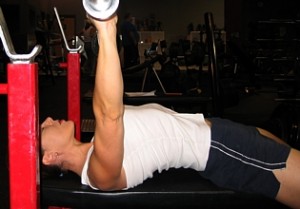
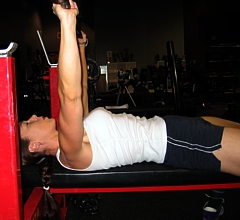
Note: lifters with pre-existing back problems (especially disk issues) often cannot bench with even the slight arch shown in the picture on the left. However, even if they bench with a flatter low back (as shown in the right), the chest should still be lifted and the shoulders pulled back.
The above may be a little easier to see from the top of the lifter. The picture on the left shows the shoulders pinned back under the lifter, the picture on the right shows the shoulders rolled out from underneath the lifter and shrugged up towards the ceiling. The left picture is the correct start and finish position, that is the shoulders should stay pinned behind the lifter throughout the rep and set.

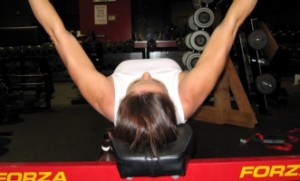
The next thing I want to look at is the proper starting and finish position for the bench, in terms of where the bar should end up. If you look at the picture entitled “Correct Start Position” above, you can see that the bar is directly vertical to the lifter, that is the arm is perpendicular to the body.
This means that the only real effort is going into keeping the arms locked. Contrast that to the following two pictures showing the bar being too far back over the lifter’s eyes (left picture) or too far towards their feet (right picture). Both positions are wrong and require more muscular effort to keep the bar in place compared to having the bar vertical.


Again, the bar should both start and finish in the same position, with the arms vertical and the bar directly above the lifter.
Now one of the long-standing arguments about bench pressing for years has been over the proper bar-path with some advocating what is termed the J-curve path and others advocating a straight line.
For various reasons, I teach a slight J-curve. Meaning that from the above starting position, the bar is lowered in a slight curve to the chest, and is pushed back up (towards the eyes) to the proper finish position discussed above.
Unfortunately, this doesn’t show up terribly well in pictures (see the video at the end of this article to make it clearer) but if you look at the next two pictures (showing the proper start and finish position), you can see that the bar hits the lifter further down the body compared to the starting position.
This is due to the lifter lowering the bar in a slight gradual curve to the chest prior to pressing it back and up (in the same curve) to the proper ending position.
Also note that, at the bottom, the elbows are tucked slightly in towards the body, anywhere from 30-45 degrees would be common. That is in contrast to a heavily geared bench where the elbows are generally tucked more, or a bodybuilder style bench where the elbows are flared higher up. Again check out bench press variations if this is unclear.

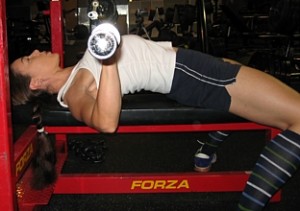
Again, this isn’t profoundly clear in the pictures but can be seen in the video at the bottom of the page.
Now, a comment about proper bottom position mechanics. In the picture above and to the right, you’ll note that the elbows are directly underneath the bar, that is the forearms are perpendicular to both the bar and floor.
Common Bench Press Technique Flaws
A common technique flaw is to have the elbows either behind (bottom left) or in front of the bar (bottom right) both of which mess up not only bar path but prevent the lifter from actually putting their force into the bar. In the first case, the lifter will end up pushing the bar towards their feet, in the second, the bar has basically collapsed back onto them and they are unlikely to get the bar moving off the chest at all.
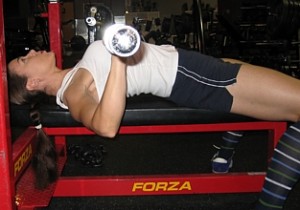
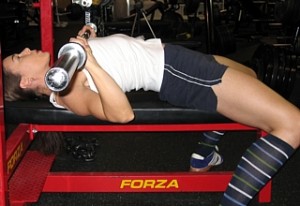
Grip Width
Finally, I want to look at the issue of grip width; as noted above, the elbows are tucked into the body slightly in the generic power bench and this has implications for proper grip width. At the bottom of the lift, the grip should be such that the forearms are perpendicular to the bar and floor. This is shown below.
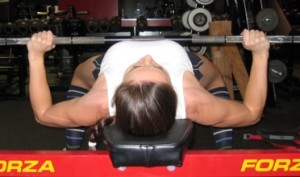
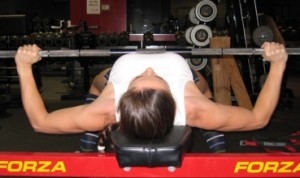
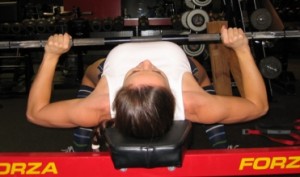
Certainly there are a lot of details to bench press technique that I left out but the above should at least get you started to benching better than most people in your gym (unless you train at a PL’ing gym or something).
Similar Posts:
- Lat Pulldown Technique
- Bench Press Variations
- Cable Row Technique
- Split Squat Technique
- Clean Style Deadlift Technique
Reading this post made me realize — finally — why my dumbbell bench press (added together) is stronger than my barbell press! (Not that either is very strong). This had been really perplexing me, but I think it’s because it’s much easier to get the pectorals engaged when using dumbbells.
From the point of view of strength development — as opposed to powerlifting training — is there any advantage to the barbell? I’d been using dumbbells because they are easier on the shoulders, in my experience.
Thanks for a great post.
Lyn
Benching with scaps adducted and using the other tips in Lyle’s article really helped me to overcome my AC joint pain. I still get some occasional AC joint inflammation after benching but I think it’s usually because I let my form go (eg. I allow my scaps to abduct) during the course of a hard set.
As I train alone, one thing that helped me to keep my scaps adducted during lift-off was to lower the pins one step from where I used to rack the bar. It feels harder to lift the bar off the pins because it’s all triceps and not shoulder raising but it enables me to keep my shoulders in the correct position for the set. It’s almost impossible to get your shoulders back and your scaps adducted correctly once you have the load in your hands.
I also find that a conscious effort to keep my lats tightened helps with stability and drive out of the bottom position.
This was something I actually wasn’t able to really address in the article in detail although I tried to show it in the video (showing a proper handoff) . If the safety catches are too high, or the person doing the handoff does a bad job (lifting the bar up and out instead of out), all of the lifter’s work to get the scapula pinned back beneath them are for naught.
It’s better to start with the catches slightly too low (if possible, most benches aren’t that adjustable) and/or get a good handoff. If that’s not possible, the lifter will have to bring the bar out, then get their shoulders back behind them prior to doing the set. It’s not ideal and I don’t think it’s great for the shoulders with a heavy weight but it’s all that can be done in that situation.
Lyle
Crud, the system deleted my comment about barbell vs. dumbbells.
Basically, both have pros and cons. DB’s tend to let people find their own path and may be easier on the shoulders and elbows compared to being locked into a straight bar. The downside is that weight may be limited by balance/stabilization issues and starting it from the bottom without a spotter can be tough (and harder on the shoulders). Of course you can dump them easily if you fail.
Barbells are easier to start (top of the rack) and let you use more weight (less balance/stability) but there is always the possibility of getting pinned if you train without a spotter and folks with wonky shoulders or elbows often get locked into a bar path that isn’t ideal for them.
For a non-powerlifter, I don’t think it matters that much. Pick the one that lets you train safely and without injury and lets you make long term progress. That’s far more important than any details about specific movements.
Lyle
Thanks for this informative post.
I would like to clarify two things:
1. Her correct lower back arch, as shown and described on the left photo in this article, looks pretty excessive to me, almost to a point where one should rely on his iliapsoas flexibility to bench. Where is the back arching “limit” for people without back issues?
2. Regarding the last sentence: “Oh yeah, her butt stays on the bench and yours should too.” – Could you further elaborate on keeping the butt on the bench rule?
As far as I gathered from this post, keeping in a correct bench pressing posture, should not allow you to raise your butt, since your lower back is fully arched. Is that the case?
Thanks,
Guy
My model is very flexible,her arch might be slightly excessive relative to what most can accomplish. As a general rule, the low back in an anatomically neutral (slight curvature) position is fine.
I don’t understand the second question: look at your average gym bencher, when it gets heavy he’ll lift his butt off the bench to turn a flat bench into a decline bench press. Don’t do that.
Hey Lyle,
About the 2nd question – will he be stronger that way, hence able to accomplish the lift and might the “butt lifting” cause unnecessary risks to his back?
Thanks.
The reason folks bridge when it gets heavy is because it turns a flat bench into a decline bench press which has better leverages. Basically, the trainee will be stronger in that position.
It’s the same reason that guys doing incline bench too heavy will lift their butt off and try to turn it into a flat bench: the leverages are better that way.
The reason he should keep his butt on the bench is to avoid looking like every other gym douche and actually performing a bench press the way it’s meant to be performed. If he wants to decline bench, he should decline bench. If the goal is training the pecs via the flat bench press, the butt stays on the bench.
@Lyle
You write:
“With that said, I would note that some types of body mechanics often make the bench press a poor choice of exercises for targeting the pecs (especially without tearing up the shoulders). Usually this is folks with very very long arms for whom full-range bench pressing tends to do awful things to the shoulders.”
This might be very applicable to me. What pec exercise do you recommend for us with long arms that won’t give us tendinitis?
Thanks in advance.
Pec deck for the win.
Seriously.
Lyle
I was wondering how to properly do a bench with the smith machine vs a simple barbell. I started using it since I didn’t feel comfortable doing a standard bench without someone spotting me. However, currently the movement fells a bit unnatural.
Appreciate the input.
Simple, you don’t. Smith machines lock people into weird movement patterns and I highly recommend against them.
i’m glad someone brought up the point of the smith machine. i was briefly a member of a gym heavy into machines, and the only place to do a bench press was with a smith machine, and i couldn’t get used to the straight up and down movement. fixed that problem – joined a gym with a free weights room!!
Excellent article on proper bench press technique and form. A lot of people just don’t understand how to perform this exercise with the right form. Unfortunately, they often times end up injuring themselves in the process. I’ve put together a short article and video detailing how to perform the bench press with good weightlifting form over at my site as well as a link to this awesome article.
I really like this article. its well written and hits the major issues of the bench movement clearly. One more big debate on the bench that would benefit from your input…
elbow position at the bottom of the movement and touching your chest. when people like me touch bar to chest my elbows go below the bench. well below. Some people argue you need to keep elbows in line with the bench, or more accurately, keeping your upper arms parrallell to the floor (90 degrees). That would keep the BB a good 6 inches above the chest in my case.
What are your thoughts on this?
Matt
“With that said, I would note that some types of body mechanics often make the bench press a poor choice of exercises for targeting the pecs (especially without tearing up the shoulders). Usually this is folks with very very long arms for whom full-range bench pressing tends to do awful things to the shoulders.”
I bench with my shoulder blades retracted, bum on the bench and a small arch; (lower back about 2-3 inches off the bench, fist depth) is this safe?
Thank you
“shoulders pinned back”. When doing standing military press(or any free weight shoulder press), does this apply as well?
Good article, Lyle. One question, I’m following your generic bulking routine and I was wondering if it would be a good idea to switch up the barbell bench with dumbbells from the first upper body day to the next? I feel like dumbbells hit my chest differently than barbell but I want to still keep barbell bench in there as I may get more into powerlifting in the future.
Your comment/question, while interesting, has no relevance to this article. Go to the support forum.
This post has really helped me realise some errors in my technique. Next session I’ll be decreasing the weight and following your technique pointers to try and fix things up. Note to self: keep forearms vertical from all angles throughout the entire rep, every rep. Thanks, Lyle.
I am 6′ 4″ , weigh 290, and bench nearly 500, drug free and no equipment (raw). I have been lifting for nearly 20 years and still think I have more strength to gain, before I have to begin one thing I truly dread… downsizing!!!
I compete in NASA (Natural Athlete Strength Association), in the Unequipped Bench-Press 308 Pure Division. As you can probably guess, my competition numbers are not as high as my “Gym Numbers”. NASA has very strict rules on technique (which is a good idea for safety and fairness).
Thanks for the article. In my opinion, this is one of the best articles for someone just starting to bench.
It would be awesome if you could post an article on shoulder/military press technique. I’m starting to get better at it, but I still don’t think I have the best technique.
Also, I just want to say that for me personally, if you get the grip width and the shoulders pinned back correct, benching just comes naturally. For many, many years I had a grip that was too wide and I never pinned my shoulders back.
The result? I could still see gains, but I ended up man boobs, not properly trained pecs. Once I corrected these two issues, I fell in love with the bench again!
My form could use a little work. Any tips on how to keep your butt down during heavy lifts? Sometimes I do and sometimes I don’t keep it down.
Don’t let it come up. Seriously, that’s what it takes.
Hey Lyle!
I have a question about the grip width. It’s pretty hard to find the grip where the the forearms are perpendicular to the bar and floor. I mean that I can have a pretty wide grip and have the forarms perpendicular to the floor, but then I also need to flare out the elbow, which I don’t think is good for the shoulder health? Anyway, with a wide grip and tucked in elbows, the elbows are way far from perpendicular to the floor. But that wouldn’t be good for shoulders either I guess.
I filmed my benchpress and did the movement naturally with different grip widths. When the grip were 56cm from forefinger to forefinger then the forearms turned out to perpendicular to the floor. Isn’t 56cm pretty close?
PS. I have pretty long arms and won’t screw my shoulders again which I did a year ago. I rather decrease the weight on the bar and have a narrower grip, if that’s safer.
Thanks in advance!
Thanks man, I spent all day today working on form, read your articles on pec stimulation and benching with variation but I found this by luck using search on your forum. What helped me ” feel ” it was just arching my back more while keeping my butt on the bench, thanks again.
Lyle,
Does this technique transfer over to Push ups too?
My bodyweight is 85 Kg. I am now benching 270 Kg ( one rep) with wide grip. In short grip I did 10 reps with 200 Kg and 3 reps with 240 Kg. Kindly advise me how to improve further. Also tell me in detail the benifits with short grip and wide grip and which one gives more srength.
Hi Danne,
In short you won’t hurt your shoulder going wider on the grip so long as you do the proper form. Some people have weak rotator cuff and need to do exercises to strengthen them because they have long arms like yourself as well, like me to. Also make sure you warm up and no jerky movements. Also see if you have rounded shoulders, if so then you need to stretch your chest.
Good luck,
Troy
Hi lyle,
I have a problem with benching in that there is alot of pressure on my wrist, i realize this is most likely to do with poor form but im not sure how to rectify it. the only thing i can think of is that my grip widens as i go through the set because at the top of a bench i kind of lock out. could this be the problem and how do i solve it please?
thanks
Thanks for the great info and pics. I always have a hard time teaching my students the correct way to perform the benchpress. Most of them learned it in high school, many moons ago and things have changed.
The pics will be great to show them and the results speak for themselves.
One thing I was wondering: why do you recommend the J-curve bar pattern rather than straight up and down? The shortest path between two points is the straight one. Is your issue to do with possible shoulder damage from the straight up and down path?
Thanks in advavnce for any clarification (my bench is very poor and I’m trying to really focus on technique right now to fix it).
Lyle,
thanks for this article.
dmitry
Great stuff as usual Lyle. I find the bench press to be an exercise which is very specific to one’s body leverages and which requires the individual to play around with grip width for some time until finding the optimal one.
Take care.
So glad I found this website and page. Looks like i’ve been benching the wrong way for almost 8 months now. I guess thats why my tri’s and delts are getting bigger but my chest development is wayy behind. Even just sitting here right now, I’m practicing pining my shoulders back and doing a pressign motion and I can totally feel my whole chest being utilized. Looking foward to chest day tommorow! Thanks Lyle.
As powerlifting is becoming more popular, I see a lot of people against the arched back. Can you expand on why it’s “so bad” by some people?
Extremely excessive arches as are often seen in top level PL are hard on the low-back, putting some pretty intense compressive forces on the disks. Beyond that, I generally suggest that if someone is making a claim that something is bad, it’s best to ask them what their rationale is. I can only speculate.
Should I straighten my arms completely at the top position? Some people say one should lock out the elbows when bench pressing and others say this would ruin your elbows because the whole weight would rest on the joints then. That’s why you should keep your arms slightly bent at the top position.
What is your opinion about that?
[WORDPRESS HASHCASH] The poster sent us ‘1762401312 which is not a hashcash value.